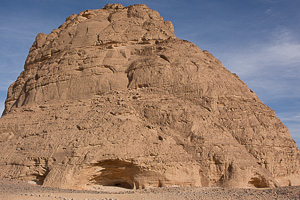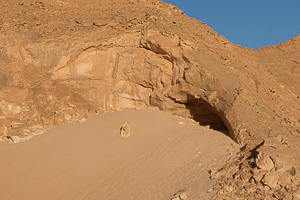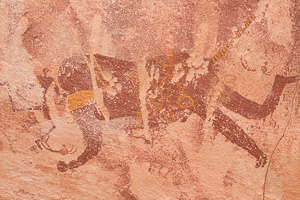The plateau of Gilf Kebir is located in the deep south-west of Egypt in the border region with Libya and Sudan. This time, it took 8 days as we crossed the Great Sand Sea. It takes normally 4-5days at the minimum by 4WD car. Gilf Kebir means “great barrier” in Arabic language. The plateau shows dominant cliffs of about 500m from the sand sea and it is composed mainly with sand stone. The base rock of sand stone forms, by weathering, tours and temples with some shelters at the bottom where Neolithic people lived and left the rock art.
January, 2014
ギルフ・ケビールはエジプトの南西端に位置し、西はリビア、南はスーダンとの国境に接している。今回はグレート・サンド・シーを経由したため8日目に着いたが、最短ルートでも四駆で4-5日を要する。ギルフ・ケビールとはアラビア語でgreat barrierを意味する。その名の通り、グレート・サンド・シーを遮るようにそそり立ち、地表から500メートル程度の高さの平らな台地となっている。台地は主に砂岩でできており、風化により尖塔や岩塊が形作られている。岩塊の裾の部分には風化によって岩陰が形成され、新石器時代の壁画が残されているものがある。
2014年1月
 |
 |
 |
| Cave of Swimmers 泳ぐ人の洞窟 | Cave of Foggini – 360-degree panorama – Many engravings at the upper part of the facade フォッギーニの岩陰 – 360度パノラマ – 正面上部に多くの刻画 | Fresco of Foggini フォッギーニの壁画 |
I was dreaming to visit the Cave of Swimmer in Gilf Kebir since 17 years when I saw the movie “The English Patient”. There were two very impressive scenes for me. One is the flight over the dunes colored in red with the sun set. Another one is the scene of rock art appearing with a torch in the cave. I visited the dunes of Ksar Ghilane in Tunisia where the movie was made but it was very disappointing. But I finally found the red dunes at Wadi Assib located in front of Gilf Kebir! My Expectation for the Cave of Swimmers became very high after Wadi Assib. The Cave of Swimmers was found and named by a Hungarian Count Lazro Almasy in 1933. The real Almasy is different from the personality of the movie. But he joined the German army during the WWII as his country was a part of Gernamy and he had to fight against the friends of exploration such as Patrick Clayton who joined the British army. We reached the Cave of Swimmers on the eighth day after departing Cairo. The Cave was unexpectedly very disappointing. Although it is called “cave”, it is a small rock shelter of around 10m width and 4m depth, not like the deep cave requiring a torch as shown in the movie. Nearly a half of the surface was fallen off and there are many graffiti around the cave. The surface is very fragile and bad behaviors of tourists seem accelerating the damage. The “swimmers” do not look like swimming but flying like sky divers. It looks they are flying to the “head-less beast”. There are paintings of negative hands and human figures with different poses. The copy drawing made by Katharine in the movie, three dancers depicted inside a negative hand is a true painting, located at the left-center. The cave of Foggini, found in 2002 by a tourist Foggini, is very well preserved and it is quite impressive with thousands of images. There are many “swimmers” and “head-less beasts”. Some of the beasts are swallowing the people. There are hundreds of negative hands and uncountable number of human figures which are showing different poses/movements, sometimes unusual poses in the daily life. Their orientations vary very much and sometimes upside down. It is said that the fresco is depicting the afterlife and it is difficult to deny. The fact that it is difficult to find scenes of hunting which is the most important thing for the present life seems proving this theory. It is said that the main part of this fresco was made in the period between BC6000 and BC4500 but its exact dating is still unknown. Some researchers indicate an influence to the Book of the Dead written a few thousand years later. The dead revives by swimming in the primordial water (Nun) and there is no revival possibility of a guilty dead whose heart is eaten by Ammit, who has a head of crocodile with human/lion body. But there is no proof that the people who left the fresco are the ancestor of the Egyptian people who developed the Egyptian civilization. At the Cave of Foggini, there are also many engravings of giraffes, ostriches, antelope and human figures. These engravings are assumed older than the paintings. They are mostly at the upper side of the fresco, even on the top of the rock, outside of the shelter. After the discovery of the Cave of Foggini, activities of rock art hunters were increased and 17 caves were found in 8 years. Five caves out of them have the headless beasts. There are many caves with rock art also in Gebel Uweinat located in the border region with Sudan and Libya, at around 100km south of Gilf Kebir.
ギルフ・ケビールの「泳ぐ人の洞窟」を訪ねたいと思ったのは映画のイングリッシュ・ペイシェントを見てからで、17年後に漸く実現することができた。映画では、夕日に染まった赤い砂丘群の上を飛ぶシーンと洞窟に入ってトーチで照らすと無数の人物画が浮かび上がるシーンが印象的であった。赤い砂丘を見たくて映画を撮影したチュニジアのクサール・ギレンまで行ったが、映画のようには赤くなくて失望した。しかし、ギルフ・ケビール台地を前にしたグレート・サンド・シー最南端のワディ・アシブでついに本物の赤い砂丘を見ることができた。
この洞窟は1933年にハンガリーのアルマシー伯爵が発見し、「泳ぐ人の洞窟」と名付けた。実際のアルマシー伯爵は映画や小説の設定とは別人だが、第二次大戦ではハンガリーがドイツに併合されていたこともあってドイツ軍に従軍して、探検仲間であったイギリス軍のクレイトンなどと戦うことになったとのことだ。
カイロを出て8日目に漸くたどり着いた「泳ぐ人の洞窟」は残念ながら期待外れのものだった。洞窟(cave)と呼ばれてはいるが、実際には間口10m、奥行き4m程度の岩陰(rock shelter)に過ぎない。映画で描かれたような光の射さない奥深い洞窟ではなく、トーチで照らす必要もない。岩壁の絵は半分近くが剥がれ落ちているようで、絵のないところは落書きだらけだ。エジプトの著名な文化人の名前まで刻まれているとのことだ。ナポレオンでも各地に自分の名前を刻んだというから、貴賤を問わない人間の欲望のようだ。これほど傷みが激しいのは、岩壁がミルフイユのように剥がれやすくなっているのと、近年の観光客が傷つけたからとのことだ。
「泳ぐ人」は泳いでいるというよりは、足と手が上に反っていてスカイダイビングのように空中を浮遊しているように見える。彼らは「頭のない獣」に向かって浮遊しているようだ。他に絵具を吹き付けた手形や様々なポーズの人物像が描かれている。映画の中でアルマシー伯爵の恋人が描いた模写、手形の中に3人の人物が踊っているように見える絵は実在していた。阿波踊りを踊っているようにも見えてユーモラスで面白い。
翌日訪れたフォッギーニの岩陰は保存状態も良く、「泳ぐ人の洞窟」とは比べ物にならないほどおびただしい数の絵に圧倒されるばかりだ。2002年に観光客(と言っても毎年1か月間当地に滞在する富豪)のフォッギーニ氏によって発見された壁画で、「泳ぐ人」と「頭のない獣」も多数描かれている。獣が人を飲み込んでいるような場面もある。多数の手形とともにおびただしい数の人物像が描かれているが、それぞれが異なる形や動きを見せている。通常の生活では見られないようなポーズも多い。向きも様々で上下が逆になっている人物像も多い。これらの絵は死後の世界を描いたとする説が通説となっているようだが、うなずかざるを得ない。狩猟などこの世で最も重要な食糧調達の場面がほとんど見られない点も死後の世界を想像させる。おびただしい数の絵を前にすると、描いた人々の情念のようなものを強く感じる。簡単には消化できない壁画だ。
描かれた絵の多くは紀元前4500年あるいは同6000年程度とする説があるが、正確な年代は分かっていない。数千年後に書かれた「死者の書」への影響を指摘する研究者もいる。死者は原始の水(Nun)を泳いで再生する、また、罪多きものはワニの頭を持った半獣神アメミットに心臓を食べられて再生できない、というエジプト神話だ。しかし、エジプト文明の担い手が壁画の作者たちの後裔だとする証拠はなく、推論の域を出ない。
フォッギーニの岩陰には制作年代がより古いとされている刻画も見られる。特に人物像や手形が描かれた場所の上部に集中し、岩陰外側の上の方までキリン、ダチョウ、オリックスかガゼルのような野生動物が多数描かれている。
2002年にフォッギーニの岩陰が発見されて以来、壁画ハンターたちの活動が活発化したようで9年間で17の岩陰壁画が発見され、そのうち5か所には頭のない獣が描かれているという。ギルフ・ケビールからさらに100㎞ほど南下すると、スーダン・リビアの三カ国の国境が接する山岳地帯のジェベル・ウエイナットがある。ここにも壁画のある岩陰が多くあり、砂岩特有の景観も見事とのことだ。以前はエジプト側からスーダン、リビアに入って周遊することも違法ではあるが可能であったらしい。今そのようなことをしたら軍に攻撃される可能性が高い。それ以前に、軍人1名と警官4名にエスコートされているのでそのような行動は取れない。北緯23度以南の国境地帯に行くにはエスコートの警官を2倍にしなければならないとのことで、そのコストの負担も増える。また、GPS発信機の取り付けが近々義務付けられるようで、さらに行動は監視されることになる。コストの問題はあるが、安全上は良いことであり、壁画の保存上も望ましいことだ。ジェベル・ウエイナットはスーダン側も素晴らしいようで、どちらから行くかが悩ましいところだ。
